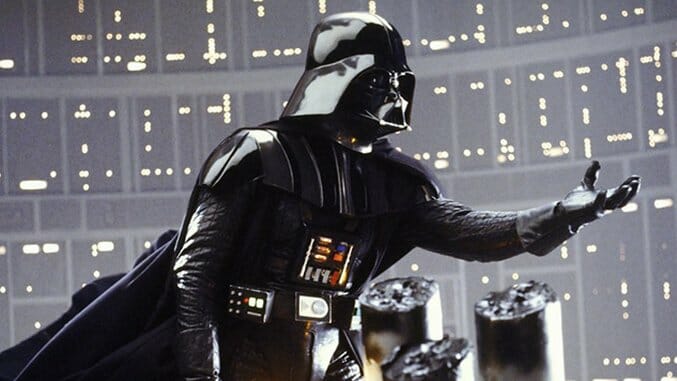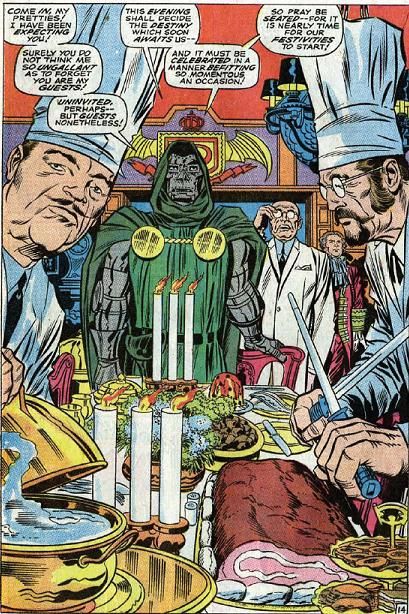Why Jack Kirby is (Probably) the Forgotten Father of Star Wars and Rogue One
Comics Features Jack Kirby
Comic book writer, artist and editor Jack Kirby is getting more credit than ever these days for his numerous contributions to pop culture. He co-created nearly all the major Marvel heroes, including Captain America, the X-Men, the Fantastic Four, the Hulk, the Black Panther and Ant-Man. He also created Darkseid—DC’s top villain, who is heavily rumored to turn up in the Justice League movie. But Kirby deserves credit for another achievement: his characters and concepts are an unappreciated influence on Star Wars, including Rogue One, which hit theaters this week. When you look at Darth Vader, the force and even the language of Star Wars, it’s hard not to see a little Kirby Krackle.
Rogue One is bringing back Vader, a key piece of Kirby’s influence. Back in 1961, Kirby and writer Stan Lee created Dr. Doom, the armored monarch of Latveria, who menaced the Fantastic Four from inside a metallic shell. None of the bungled Fantastic Four films has even attempted a comics-faithful version of Doom, and maybe there’s a reason for that: Darth Vader is already damn close to Doom. Vader’s looks (badass armor that hides scars) and personality (both have a certain nobility) have always been suspiciously Doom-like, as many comic creators have noticed, including Mark Evanier, Frank Miller, and Doom’s co-creator, Stan Lee.
In a 1979 collection of Fantastic Four reprints, Lee plays up the comparison in his typical style. While introducing issue #87, Lee writes, “Hey, gang, have you seen Star Wars? Okay, okay, I realize that’s like asking if you can spell your name. But anyway, remember the villain, Darth Vader? …you are about to meet one of our own Marvel villains, and I just suspect that you might notice the teensy-weensiest little resemblance! And, in case you’re wondering, Dr. Doom came first—by about 15 years, give or take a micro-minute or two!” This was a particularly good issue to point out the resemblance, since a lavish image of dinner with Doom seems a likely inspiration for a Cloud City scene in The Empire Strikes Back.

Fantastic Four Interior Art by Jack Kirby
Beyond Vader, the mythology of Star Wars is also reminiscent of Kirby’s Fourth World. When Kirby left Marvel in the early ‘70s after falling out with Lee, the “King of Comics” went to DC and immediately created a new universe (the Fourth World) full of characters called the New Gods. Kirby’s epic story involved an evil father (Darkseid) battling his good son (Orion). The son struggled with his heritage: how much evil did he inherit from Daddy? Meanwhile, all the New Gods recokoned with the power of the Source: a mysterious, all-powerful energy that bound everything in existence. Sound familiar? If that’s not coincidental enough, Orion wields a related power called the Astro-Force.
Darkseid himself can be considered an influence on the Star Wars mythos. This ultimate embodiment of evil, no doubt inspired by the fascism Kirby literally fought in World War II, seeks domination with the enthusiasm and scope of a galactic empire. His name—pronounced “Dark Side”—would also seem to be a gift to Lucas, whose characters endlessly prattle about the dark side and light side of the force. This phrase is also one of the most successful lexical contributions of Star Wars, as anyone who sells out can be described as “turning to the dark side.” The expression is also used humorously, as in a recent Grazia lifestyle post: “Emma Watson has turned to the dark side (dyeing her hair a deep brunette).” Such jokes may owe an indirect debt to Kirby.
Someone who’s given a lot of thought to Kirby and Star Wars is Tom Scioli, a Kirby-influenced artist whose work can be seen in his creator-owned American Barbarian comic, the exuberant crossover Transformers vs. G.I. Joe and the current Super Powers backups for Cave Carson Has a Cybernetic Eye. Scioli told Paste that the Kirby-Star Wars connection is “complicated” and “The Pact” (the story in New Gods #7) is “the Star Warsiest thing Kirby’s done… It’s a very epic, very sci-fi, very mythic and very cinematic comic at a time when no one else was doing cinematic comics. It’s SO similar to Star Wars, but I’ve read Lucas’s early script drafts and it seems like he really did arrive at that story honestly. It’s something I’ve pondered for a long time and can argue both sides.”
There is some second-hand evidence that Kirby himself felt that Lucas borrowed from him. In an article about the friendship between Kirby and Frank Zappa, Zappa’s son, Amhet, told Royal Flush magazine that, “…Jack confided in Frank that he felt like the stories he created helped shape the Star Wars saga, that he saw direct parallels between his characters and the movie’s story arcs… He told my dad stuff like, ‘Darth Vader was Doctor Doom and the Force is the Source’ and that George Lucas ripped him off.”
While we might never know for sure if Lucas was as inspired by Kirby as admitted influences Flash Gordon and Akira Kurosawa, there’s no question that the impact of Kirby was and is huge. Steve Rude—a legendary artist whose work can be seen in Future Quest and the Nexus Newspaper—told Paste: “Thousands of people, pro and amateur, have been touched by what Jack Kirby chronicled in his work, and everyone is influenced by everyone else. If Lucas was inspired in his writings to incorporate things he learned from Jack, why not?”
Rude emphasizes the complexities of creation: “The best people can do when they’ve been lucky enough to come upon something brilliant and truthful is probably to do what Lucas did—to channel what he learned from Jack’s Fourth World books into his own work, assuming he had read them in the first place. Coincidences happen all the time, and who can rightfully explain them?”
Whether you prefer Doom or Vader, the Source or the Force, there’s no question that Kirby’s bombastic, kinetic style has inspired storytellers of all sorts, on the page and screen. Some words from Rude are hard to argue: “…for right now, look beyond momentary controversies to a future where Kirby’s works will eventually reign alongside all other works of high literature that have spanned the centuries. I have little doubt that moment to come to pass.”